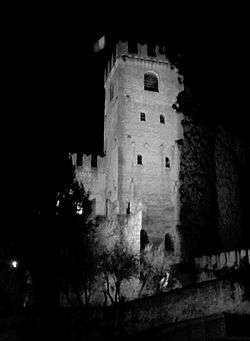Conegliano
| Conegliano | |
|---|---|
| Comune | |
| Città di Conegliano | |
|
The castle by night | |
 Conegliano Location of Conegliano in Italy | |
| Coordinates: 45°53′12.32″N 12°17′50.6″E / 45.8867556°N 12.297389°ECoordinates: 45°53′12.32″N 12°17′50.6″E / 45.8867556°N 12.297389°E | |
| Country | Italy |
| Region | Veneto |
| Province / Metropolitan city | Treviso (TV) |
| Frazioni | Ogliano, Scomigo, Collalbrigo |
| Government | |
| • Mayor | Floriano Zambon (PdL) |
| Area | |
| • Total | 36 km2 (14 sq mi) |
| Elevation | 74 m (243 ft) |
| Population (May 11, 2008) | |
| • Total | 35,436 |
| • Density | 980/km2 (2,500/sq mi) |
| Demonym(s) | Coneglianesi |
| Time zone | CET (UTC+1) |
| • Summer (DST) | CEST (UTC+2) |
| Postal code | 31015 |
| Dialing code | 0438 |
| Patron saint | Leonard of Noblac |
| Saint day | November 6 |
| Website | Official website |
Conegliano (Italian: [koneʎˈʎaːno]; Venetian: Conejan) is a town and comune of the Veneto region, Italy, in the province of Treviso, about 30 kilometres (19 mi) north by rail from the town of Treviso. The population of the city is of 34,891 [1] people. The remains of a 10th-century castle are situated on a hill that dominates the town. Formerly belonging to the Bishop of Vittorio Veneto, what remains is a bell tower, which now houses a small museum, and outer walls.
Industry
Conegliano is noted for its wine, chiefly the dry white Prosecco (made from the grape of the same name) which comes in three varieties: tranquillo (still), frizzante (slightly sparkling) and spumante (sparkling). It is also home to Italy's oldest and most prestigious wine school called Scuola Enologica.
It is also home to the Istituto Sperimentale per la Viticoltura where several Italian grape varieties have been bred, including Albarossa, Vega and Valentino nero. Additionally, viticulturalists at the institute have helped saved many native Italian grape varieties from extinction, such as the Valpolicella grape Bigolona.[2]
There is also a great industrial tradition, especially specialized in home appliances.
Colli di Conegliano DOC
The hills around Conegliano are home to the Denominazione di origine controllata (DOC) zone of Colli di Conegliano. Here both red and white Italian wines are produced at a variety of sweetness levels from dry to sweet passito dessert wines. Grapes destined for DOC wine production must be harvested to a yield no greater than 12 tonnes/hectare. The finished wine must attain a minimum alcohol level of 12% for the red wines and 10.5% for the whites in order to be labelled with the Colli di Conegliano DOC designation.[3]
The red DOC wines are made Merlot (10-40%), Cabernet Sauvignon, Cabernet Franc and Marzemino (at least 10% of each with no maximum for the last three varieties) and up 10% of Incrocio Manzoni 2.15. The wine is required to be aged at least two years in barrel prior to being released. A sweet red passito labeled as Refrontolo is made from at least 95% Marzemino with up 5% of other local non-aromatic varieties permitted to round out the blend.[3]
The dry white of the DOC is made from at least 30% Manzoni bianco with between 30-70% collectively of Pinot blanc and Chardonnay and up to 10% total of Sauvignon blanc and Riesling Renano. The passito style Torchiato di Fregona can be made in both a dry and sweet style from at least 30% each of Glera and Verdiso, a minimum 25% of Boschera and up to 15% of non-aromatic varieties like Marzemina bianca and Bianchetta Trevigiana. This wine is required to age at least 13 months prior to being release.[2][3]
Culture
Every June, a special chess or 'dama' game where the pieces are represented by actual real people—known as the Dama Castellana—is performed in the historical center. This event is not the continuation of a secular tradition, but has been introduced only a few years ago, still managed to become a traditional event calendar coneglianese.
Conegliano was the birthplace of the painter Cima da Conegliano, a fine altar-piece by whom is in the cathedral (1492) and the composer and conductor at the Cincinnati Conservatory Pier Adolfo Tirindelli, .
Notable natives and residents
- Ferruccio Benini, actor.
- Ugo Cerletti, a neurologist who discovered the method of electroconvulsive therapy in psychiatry.
- Giambattista Cima, Renaissance painter.
- Paolo De Coppi, scientist.
- Alessandro Del Piero, World Cup-winning footballer.
- Marco Donadel, football midfielder.
- Maurizio Zanetti, ((scientist immunologist))
- Marco Fanno, economist.
- Pier Paolo Pasolini, poet.
- Maurizio Sacconi, politician.
- Alberto Rapisarda, illustrator.
- Tullio De Rosa, enologist and novelist.
- Stefano Curtarolo, materials scientist.
- Bruna Pegoraro Brylawski, molecular biologist.
Transport
International relations
Twin towns - sister cities
Conegliano is twinned with:
Photo gallery
-

Giano hill with the castle and Villa Gera
-

Panoramic view of the train station (from the castle)
-
San Rocco Church
-
Scalinata degli Alpini (Alpines' flight of steps)
-
Via Madonna
-
Fontana dei cavalli (Horses fountain)
-
Porta Dante
-
Via XX Settembre
-
Duomo
-
An old building in Via XX Settembre
-
Cima Square, Accademia theatre
-
Via XX Settembre (with Montalban Palace)
-
Porta Monticano
-
Porta Monticano
-

The river: Monticano
-
_da_collalbrigo.jpg)
Prosecco hills of Conegliano (in località Costa)
| Wikimedia Commons has media related to Conegliano. |
References
- Conegliano Official Website
- Exhibition Official Website
 This article incorporates text from a publication now in the public domain: Chisholm, Hugh, ed. (1911). "article name needed". Encyclopædia Britannica (11th ed.). Cambridge University Press.
This article incorporates text from a publication now in the public domain: Chisholm, Hugh, ed. (1911). "article name needed". Encyclopædia Britannica (11th ed.). Cambridge University Press.
- Notes
